

Message from the Speaker
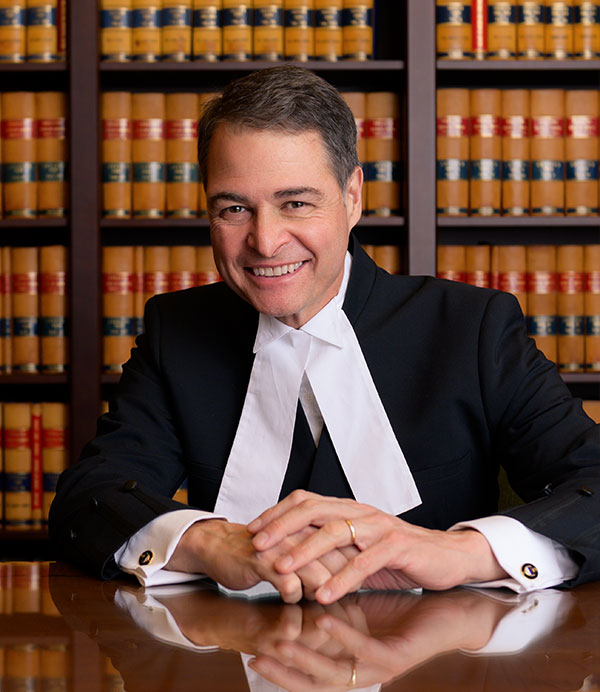
Speaker of the House of Commons
As Speaker of the House of Commons and chief administrative officer of this institution, I am proud to present the latest Report to Canadians.
On behalf of the House Administration, it is my duty to report to you, every year, the highlights of the parliamentary work of the Members of Parliament you elected. As you will see in the following pages, the past year has been one of renewal and adaptation for this organization built on the strength of its values.
The 2021–2022 fiscal year began under a special order allowing for hybrid parliamentary proceedings and ended under another order that continues to give Members the choice to sit, work and vote either in person or remotely. In the intervening period, Parliament was dissolved, the 44th general election was called, a new session opened, a Speaker's election was held, and our work resumed—enough to keep us all very busy!
Throughout this time marked by significant change, newly elected and returning Members focused on serving their constituents. Canadians remain the priority, and advocating for your interests, your needs and those of your region is the very essence of our work.
Keeping the business of democracy running smoothly would not have been possible without the support of the skilled and empowered staff of the House Administration. The expert advice and services that Members received helped them to stay on course as they sailed through the waves of the past few months. For example, for the first time, Members taking office were given the option of taking part in swearing-in ceremonies and sessions of the Members' Orientation Program in person or—for the first time—remotely. The House Administration also continued to support Members in their role as employers, so that they could focus more on their duties as parliamentarians. To that end, it provided them with comprehensive online training on staffing and launched a new application to facilitate the recruitment process for Members, their employees, and candidates.
I hope that this year’s Report to Canadians will make you as proud as I am of the accomplishments of the Members of Parliament and demonstrate how much of the House of Commons’ operations and its influence in constituencies depend on the close collaboration and professionalism of the House Administration.
Hon. Anthony Rota, M.P.

Message from the Clerk
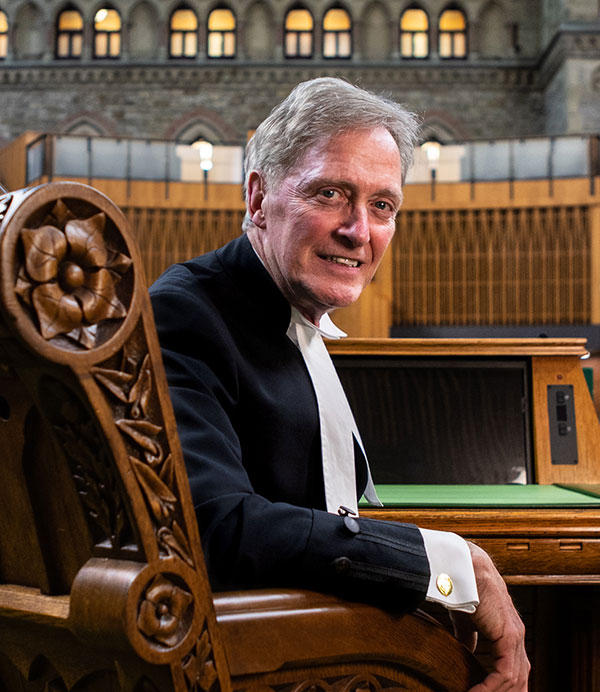
Clerk of the House of Commons
The employees of the House of Commons Administration are dedicated to providing quality services to Members of Parliament and their staff every day. Together, we play an important part in support of parliamentary democracy: procedural experts advise Members in the Chamber; information technology specialists support hybrid committees; maintenance personnel keep the buildings in the Parliamentary Precinct in good working order; legislative counsel assist in the drafting of legislation. And these are just a few examples of the roles fulfilled by our diverse workforce! As Clerk of the House of Commons, I am honoured to lead this great team of individuals who share our vision of work based on impartiality, excellence, accountability, teamwork and inclusion.
The House of Commons is proud of its traditions and strives to be an exemplary parliamentary institution. Because it is built on a solid foundation of knowledge and experience, innovation and excellence are possible here. The 2021–2022 fiscal year was another opportunity for us to demonstrate our ability to meet the changing needs of an organization greatly characterized by consistency and stability. Even after two years of uncertainty related to COVID-19, continuous improvement remained a priority: the Administration continued to seek ways to better work together, whether remotely, on site or in hybrid fashion. In many ways, parliamentary business has now returned to pre-pandemic levels, and Members, their staff and Administration employees who had been working remotely have returned to their workplaces in the Parliamentary Precinct in accordance with the sanitary measures put in place to ensure their safety.
Over the past year, the Administration remained true to its mission to be responsive to Members’ needs. It offered customized and adapted support to outgoing, re-elected and newly elected Members following the 44th general election. Onboarding and swearing-in activities for elected Members, as well as transition support for outgoing Members, were made available in person and remotely: a first for our Members’ Orientation Program.
As well, technological improvements were implemented to continue to provide a hybrid environment for committee meetings, allowing for a more secure connection and a higher-quality audio feed and giving Members’ employees the ability to monitor committee meetings remotely. The Administration also made it easier to access parliamentary information. Working with the Senate and the Library of Parliament, the Administration contributed to the renewal of the LEGISinfo website, an online tool that tracks bills introduced in the Senate and the House of Commons.
To learn more about these and other initiatives undertaken over the past year, I invite you to continue reading this report. I hope it will help you better understand the work of Members of Parliament and the Administration's important role in supporting parliamentary democracy.
Charles Robert

Highlights from the Hill
The House Administration is constantly modernizing and adapting how it provides services and information to Members of Parliament, their employees, and House Administration employees; and 2021–2022 was no exception.
The pursuit of excellence
The House Administration proudly supports Members and the House of Commons by providing the services, infrastructure, and advice that Members need to do their work as legislators and representatives in the Chamber, in committees, in caucus, and at their offices on Parliament Hill and in their constituency.
Over the past year, Members carried out their parliamentary duties while continuing to adapt their practices to the COVID-19 pandemic. At the same time, the House Administration continued to look for ways to modernize and adjust how it assists Members, whether they are working remotely or on site. Following the general election, the support available to Members and their employees was offered both in person and virtually. Also, for the first time in the history of Parliament, all newly elected and re-elected Members were given the option of a virtual swearing-in ceremony.
Relying on the collective experience of its employees, the House Administration ensured that business would continue while also introducing new programs and enhancing services to Members. Building on work begun in the 2020–2021 fiscal year, the House modernized its security records management system and implemented new services to enhance Members’ safety both on and off the Hill. These include assessments, the provision of security equipment and advice, security awareness and training, as well as outreach with local police forces.
The opening of a new Parliament creates an opportunity to reflect on the way products and services can be delivered or enhanced. Throughout the past year, the House Administration challenged itself to become better at what it does. Continuous improvement remained a priority within the Administration’s ongoing efforts to deliver outstanding services to Members of Parliament. For example, Sourceplus (a multidisciplinary team providing on-site support to Members and their staff) played an integral role in onboarding new and re-elected Members after the last general election, while also helping those who were not re-elected ease out of parliamentary life.
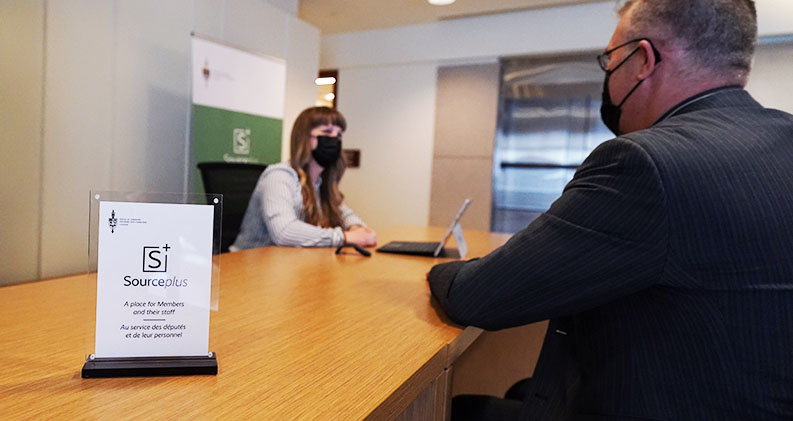
Building an anti-racist culture
The Anti-Racism Subcommittee—an employee-led task force created as part of the Workplace Inclusion Program—published its first report this year. Drawing inspiration from the recommendations, the Administration added the core value of “inclusion” to its Strategic Plan, in a commitment to emphasize anti-racist behaviour and ensure an inclusive and diverse workplace.
The importance of safe on-site operations
The House continued to follow protocols from public health authorities to help limit the spread of COVID-19 in the workplace. Some preventative measures previously approved by the Board of Internal Economy were extended, such as the closing of the precinct to the public; the suspension of public tours and committee travel; and the mandatory use of masks for Members, their staff, House Administration employees, members of the Parliamentary Press Gallery, and parliamentary visitors.
Some of the services that were paused in the early days of the pandemic have resumed, with protective measures in place to ensure safety. Parliamentary activities in the Chamber and in committees continue to take place in a hybrid format.

A timeline of significant events
Dissolution of the 43rd Parliament
Did you know? Members’ offices—both in Ottawa and in their constituency—remain open during dissolution to allow Members and their staff to continue offering services to constituents.
44th general election
After a general election, new Members participate in an orientation program outlining the support and services available to them. The program’s delivery was adapted by the Administration in response to the pandemic. In keeping with public health directives, Members were able to participate in program activities either in person or virtually.

Swearing-in ceremonies for Members of Parliament
Before taking their seats and voting in the Chamber, Members take an oath or make a solemn affirmation of allegiance. In effect, Members are making a pledge to conduct themselves in the best interests of the country.
Opening of the 44th Parliament and election of the Speaker of the House of Commons
The election of a Speaker is the first item of business when Members assemble following a general election and, when the 44th Parliament opened, Members re-elected the Honourable Anthony Rota as Speaker.
Although Speakers may not participate in House debates, they still fulfill their role as Members by supporting their constituents.
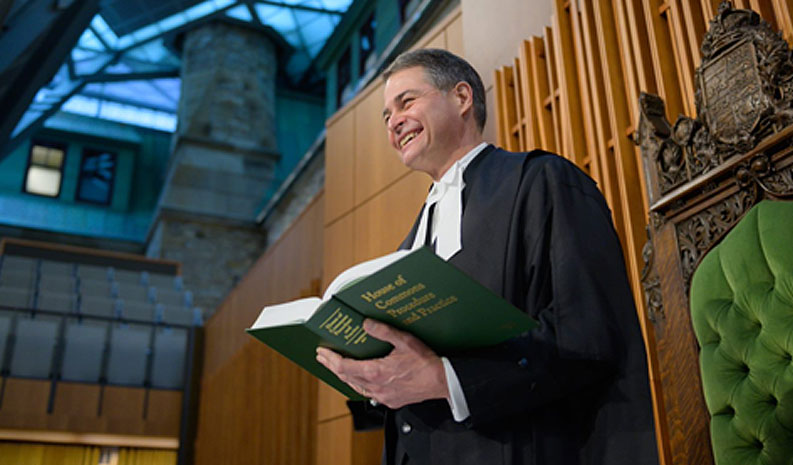
Speech from the Throne
Her Excellency the Governor General, the Right Hon. Mary Simon, opened the new session of Parliament by reading the Speech from the Throne. This was the third throne speech read in the Senate of Canada Building, the Senate’s temporary home during the rehabilitation of the Parliament Building.

Interested in the history of the Speech from the Throne?
Women in Parliament
Following the 2021 general election, more women are sitting in the House than at any other time in Canadian history.
The year 2021 marked 100 years since the historic election of Agnes Campbell Macphail, the first woman Member of Parliament. Her win came two years after women gained the right to run in a federal election. She would remain the sole female Member of Parliament for 14 years until Martha Louise Black was elected in the 1935 federal general election. Macphail kept her seat until the general election of 1940, and paved the way for many other women in politics.
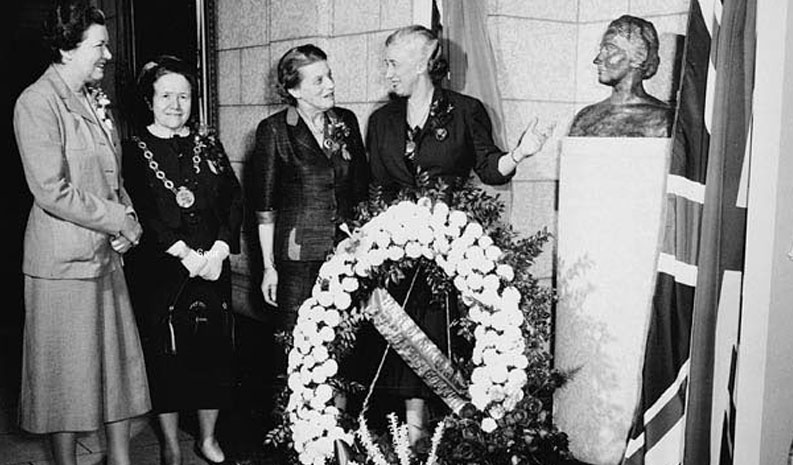
Significant progress for women in Canada's Parliament
Here are some of the pioneering women who have marked the evolution of our parliamentary institutions over the past hundred years:
-
1921
Agnes Campbell Macphail
First woman Member of the House of Commons
-
1930
The Hon. Cairine Reay Wilson
First woman Senator
-
1944
Cora Taylor Casselman
First woman to preside over sittings of the House
-
1957
Margaret Aitken
First woman appointed chair of a parliamentary committee
-
1972
Muriel McQueen Ferguson
First woman Speaker of the Senate
-
1980 and 1983
The Right Hon. Jeanne Sauvé
First woman Speaker of the House of Commons and first woman Governor General
-
1993
Jean Augustine
First visible minority woman elected to the House of Commons and first Black Canadian woman to serve as a federal minister of the Crown and Member of Parliament
-
1993
The Right Hon. Kim Campbell
First woman Prime Minister
-
2005
Audrey O’Brien
First woman Clerk of the House of Commons
-
2008
Dr. Andrea McCrady
First woman Dominion Carillonneur
-
2012
Sonia L’Heureux
First woman Parliamentary Librarian
-
2014
Johanna Mizgala
First woman Curator of the House of Commons
Honouring those who lost their lives to gender-based violence
Thirty years ago, legislation was passed to officially designate December 6 as the National Day of Remembrance and Action on Violence Against Women, when the National Day of Remembrance Act received all-party support. The Dominion Carillonneur performed a recital for White Ribbon Day, as it is informally known, honouring the victims of the École Polytechnique shooting in 1989.

Members’ Snapshot
When it first convened in 1867, the House of Commons had 181 Members. Today, that number has risen to 338 to keep pace with Canada’s geographic expansion and growing population. Every Member of Parliament is elected to represent a constituency in the House. Just as Canada’s population has changed since 1867, so has the makeup of our nation’s constituencies and the Members elected to represent them, making today’s Parliament the most diverse in our history.
Constituencies
All of Canada’s 338 constituencies (also called ridings or electoral districts) have a representative in the House of Commons. Each of these representatives—called Members of Parliament—provides a direct link between Parliament and Canadians by speaking to their constituents’ views and advocating for them in the House of Commons.
- Find the Member of Parliament for your riding.
- Find the address for your Member’s constituency office.
Every year, Members of Parliament and their teams handle thousands of enquiries from constituents seeking assistance with federal government programs and services, including:
 Employment insurance
Employment insurance Disability pensions
Disability pensions Support for veterans
Support for veterans Passports and immigration
Passports and immigration
Move around the map to see the distribution of Canada’s 338 constituencies.
Working for a Member of Parliament
Members’ employees assist them in their parliamentary functions. They are recruited directly by the Member, who determines their job responsibilities, hours of work, and pay rate.
Members’ employees usually work in either a Member’s Hill office in Ottawa or in a constituency office. Responsibilities include research and policy analysis, as well as liaising with constituents, writing press releases, and managing website and social media content.
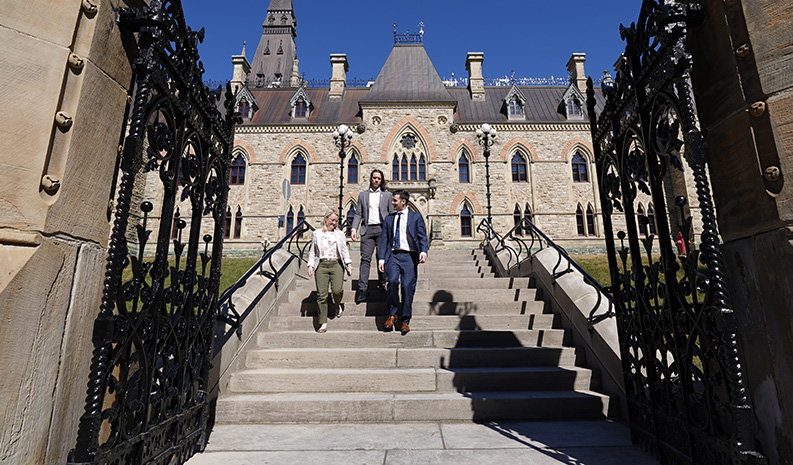
Member support from the House Administration
The House Administration supports Members in their role as employers to help them better focus on their work as parliamentarians. One example is the comprehensive, online training program to assist Members and employees in managing their office operations.
This past year, the House launched a new application to allow Members to easily submit employment-related requests such as for employee recruitment, salary changes, acting appointments, and position changes. The system aims to improve the user experience by reducing the administrative burden on Members and streamlining related processes for employees and candidates.
Parliamentary Internship Programme
Every year since 1970, the Parliamentary Internship Programme has welcomed 10 young professionals to Parliament Hill from September through June. The paid, non-partisan interns are selected through a national competition.
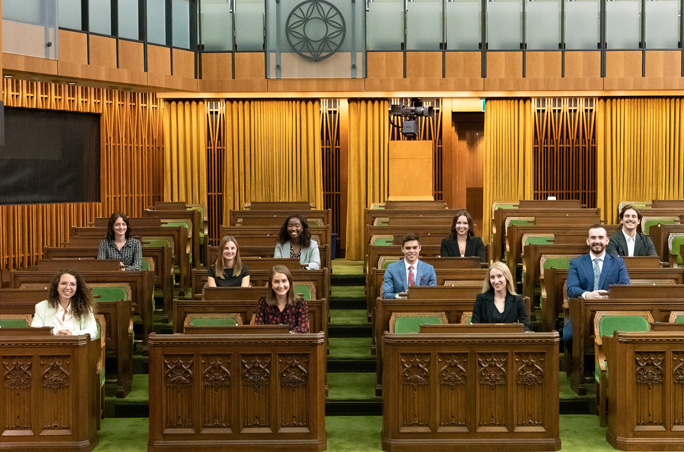
Employee health, safety and wellness: a top priority
Members’ employees are entitled to a safe and healthy work environment, whether in the Parliamentary Precinct or in a constituency office. The House Administration offers resources and training sessions to both Members and employees to raise awareness on health, safety and wellness programs and the prevention of harassment and violence in the workplace. As employers, Members play an essential role in ensuring a respectful work environment, and tools are in place to support them.
Helping Members settle in
Have you ever wondered how Members of Parliament settle into their offices on the Hill following an election? After dissolution, an office move team is established within the Administration. Last fall, a cross-sectional group of employees with experience and knowledge about House operations completed 99 moves in one month.
The Administration also ensures a smooth transition in the delivery of services to constituents by supporting newly elected Members in establishing their constituency offices. Different teams assist in reviewing office leases and material, as well as provide technical assistance to make sure offices are fully furnished, equipped and connected.

About Members of Parliament
Members of Parliament, by the numbers
For more than 150 years, Members of Parliament have upheld the principles and practices of Canadian democracy by representing the citizens who elect them.
As of March 31, 2022
Party standings
A party must hold at least 12 seats to be recognized as a party in the House of Commons. Recognition means that the party receives funding for research and staff. It also means that the party can participate more regularly in proceedings of the House and its committees.
Seats held by each political party in the House of Commons (as of March 31, 2022)
Members’ Activities
The 43rd Parliament was dissolved on August 15, 2021, and a general election was called for September 20, 2021. The 338 newly elected and returning Members of Parliament gathered for the first time on November 22, 2021, for the opening of the 44th Parliament.
In the Chamber
The House of Commons Chamber is where Members come together to debate important national issues, hold the government to account, receive documents prepared by government departments and agencies, and debate and vote on proposed legislation and other important matters. Presiding over these activities are the Speaker of the House and other Presiding Officers.
More specifically, Members’ work in the Chamber includes the following:
- Learn more about a typical week in the Chamber.
- Watch Chamber proceedings online on ParlVU.
- Discover the interim Chamber by taking a virtual tour.
The return of Parliament
Since the beginning of the COVID-19 pandemic, our institution—rooted in over 150 years of customs, practices and traditions—has had to innovate and adapt. To continue their duties, parliamentarians started meeting in hybrid format, where some Members attend proceedings in person and others participate remotely by videoconference. The House continued to sit in hybrid format until it adjourned for the summer on June 23, 2021.
On August 15, 2021, the Governor General dissolved the 43rd Parliament and a general election was held on September 20, 2021. One week before the 44th Parliament officially opened on November 22, 2021, procedural staff provided newly elected Members with a session in the Chamber as part of the Members’ Orientation Program, to inform them on their role as legislators. For the first time, the session took place in hybrid format, making it possible for Members to participate virtually. Chamber orientation takes a look at a typical sitting day, how to vote, how to participate in proceedings of the House, and provides an overview of the first days of a new Parliament. This year, the session also included a discussion on the ways in which Members participated in hybrid proceedings in the previous Parliament.
As the special order allowing for hybrid proceedings expired at the end of June 2021, Members’ presence was required in the Chamber on November 22, 2021 for the opening of Parliament and the election of the Speaker. Members were also required to consider a motion allowing for hybrid sittings of the House and committees to resume. It was the first time in almost two years that Members met in the Chamber without hybrid or virtual support. Preventative measures remained in place.
The next day, the Governor General delivered the Speech from the Throne in the Senate Chamber with limited in-person attendance. The speech was broadcast live and Members—along with all Canadians—were able to watch the event remotely.

A special order for special times
The Standing Orders of the House of Commons are a collection of the permanent rules adopted by the House to govern its proceedings. There are currently more than 150 standing orders governing the legislative process, the Speaker’s role, the parliamentary calendar, the work of committees, and Private Members’ Business, among other things.
In addition to the Standing Orders, the House may also adopt special orders, which temporarily suspend the regular rules and practices for a limited time, to deal with a particular matter. On November 25, 2021, the House adopted a special order to authorize hybrid proceedings for sittings of the House of Commons and meetings of committees, allowing Members to either attend in person or participate remotely. The motion also included provisions to allow for voting by videoconference as of November 26, 2021, and directed the House Administration to begin onboarding Members to the electronic voting application used in the 43rd Parliament. This application was reinstated on December 9, 2021, and remains in place until June 23, 2022.

How do Members vote remotely?
The electronic voting application created by the House Administration allows Members participating in proceedings remotely to vote electronically on motions before the House, while others vote in person using the traditional method.
Continued support during hybrid proceedings
Working behind the scenes, teams from across the Administration made sure that Members and their employees were properly equipped and trained for hybrid sittings. Connectivity and the security of our network were maintained to ensure Members could participate in proceedings on the Hill as well as remotely from across the country. Hybrid meetings of the House were broadcast as usual, and the public portions of committee meetings remained available for Canadians.
In committees
Through committees, Members conduct in-depth studies, consider and potentially amend proposed legislation, and examine government spending. Committees often seek input from stakeholders and will invite ministers, public servants, private citizens, experts and representatives of organizations to appear before them to provide information relevant to a study that the committee has decided to undertake.
Standing committees established under the Standing Orders of the House of Commons are empowered to study all matters relating to their mandate and the various government departments assigned to them by the House.
Standing joint committees are composed of members from both the Senate and the House of Commons and are established pursuant to the Standing Orders of the House of Commons and the Rules of the Senate.
Special committees are appointed by the House of Commons to carry out specific inquiries, studies or other tasks that the House deems important. Special committees exist until their final report has been presented to the House or until the end of the session.
Special joint committees are established pursuant to orders adopted by the Senate and the House of Commons and with membership from both houses. These committees are tasked with studying specific matters and exist until their final report has been presented to the Senate and the House of Commons or until the end of the session.

Did you know?
Over the past 10 years, a total of 12 special committees or special joint committees have been created:
- Special Joint Committee on Medical Assistance in Dying (2022)
- Special Joint Committee on the Declaration of Emergency (2022)
- Special Committee on Afghanistan (2021)
- Special Committee on the Economic Relationship between Canada and the United States (2021)
- Special Joint Committee on Medical Assistance in Dying (2020)
- Special Committee on the COVID-19 Pandemic (2020)
- Special Committee on Canada-China Relations (2020)
- Special Committee on Electoral Reform (2016)
- Special Committee on Pay Equity (2016)
- Special Joint Committee on Physician-Assisted Dying (2016)
- Special Committee on Violence Against Indigenous Women (2013)
- Special Committee on Co-operatives (2012)
- View the list of committees.
- Learn more about committees.
- Browse the list of committee meetings and watch or listen to public meetings.
First item of business
Committees started meeting shortly after the opening of the 44th Parliament. At the start of each new session, committees must first hold an organization meeting. Although the only item of business on the agenda for an organization meeting is the election of the committee chair, it has become common practice for committees to proceed immediately with the election of the vice-chairs and the consideration of routine motions. Because not all of the rules of the House of Commons necessarily apply to their activities, committees establish their own rules to follow for the duration of a session of Parliament. Each committee is free to organize its own activities, as long as it respects the powers granted to it by the House.
The Standing Committee on Procedure and House Affairs assists the House in determining the composition of many of its committees, which is why it was the first to hold its organization meeting, on December 3, 2021. The meeting was convened following a House order and conducted in hybrid format.
The House adopted a number of motions to allow the Standing Committee on Finance and the Standing Committee on Public Safety and National Security to meet on December 6 and 8, 2021, respectively. The House also ordered that the other standing committees be convened no later than December 17, 2021.

Committees at work
Committees provide an opportunity for in-depth discussions on a variety of topics. For example, during this reporting period, the Standing Committee on Foreign Affairs and International Development conducted a study of the vulnerabilities created and exacerbated by the COVID-19 pandemic over 20 meetings, starting in November 2020 and ending in May 2021. The committee heard from 62 witnesses and received 16 briefs as part of this study, which resulted in two reports. The second report, Confronting a Child Rights Crisis and Restoring Hope, was presented to the House on June 9, 2021.
One of the newest committees is the Standing Committee on Science and Research, which examines successes, challenges and opportunities for science in Canada, with reports from the Chief Science Advisor. Three new special committees were also formed during this period: the Special Committee on Afghanistan was created at the start of the 44th Parliament and held its first meeting in December 2021; further to the declaration of emergency under the Emergencies Act, the House adopted a motion on March 2 to create the Special Joint Committee on the Declaration of Emergency; and lastly, the House adopted a motion to create the Special Joint Committee on Medical Assistance in Dying on March 30.
What is the Special Joint Committee on the Declaration of Emergency?
On February 14, 2022, the federal government declared a public order emergency under the Emergencies Act, citing blockades in various locations across Canada—including downtown Ottawa—as the reason for the declaration. This was the first time the Emergencies Act had been invoked since the bill was passed in 1988. The declaration was tabled in the House of Commons and a motion to confirm the declaration was put forward and considered by Parliament. Following debate, the House adopted the motion on February 21, and the declaration of emergency was ultimately revoked on February 23. The Emergencies Act stipulates that a joint parliamentary committee composed of members of both houses of Parliament must be formed to review any declaration of emergency. The Special Joint Committee on the Declaration of Emergency was created on March 2, 2022, and met for the first time on March 14.
Statistics about committees
From April 1, 2021 to March 31, 2022, a total of 852 committee meetings were held, including standing and special committees, and their respective subcommittees. 148 committee reports were tabled in the House of Commons and these reports notably covered topics like:
- Food security in Northern communities
- Systemic racism in policing in Canada
- Zero-emission vehicles
- Urban, rural, and Northern housing
- Challenges faced by women living in rural communities
Working behind the scenes, Administration employees offered procedural, administrative, technical and logistical support to all committees. Upon request, legal advice was provided to committees, and legislation and amendments were drafted for Members for the study of bills. Between April 1, 2021 and March 31, 2022, the Law Clerk and Parliamentary Counsel appeared before parliamentary committees 8 times.
Improving virtual participation
In response to the continued need for a hybrid environment for committees, the House transitioned to a new, specially configured platform with improved security, simultaneous interpretation, and broadcasting systems to support public and private meetings. In addition, enhancements were put in place for Members’ employees to follow committee meetings remotely, while other adjustments helped facilitate the management of witness panels.
When the House of Commons adopted the special order for the continuation of hybrid proceedings in November 2021, the rule instructing all witnesses to participate remotely was extended. The Administration improved its support to witnesses to make sure the latter were properly equipped to participate in committee meetings. A key concern was making sure that sound quality was adequate for all meeting participants and that interpreters could safely do their work. As a result, specialized teams provided witnesses with online onboarding services, ensured witnesses used the recommended technology, and ran simulations with witnesses before meetings. They also tested connectivity and equipment functionality to ensure the best overall meeting experience.

International and interparliamentary activities
Parliamentary diplomacy promotes dialogue and cooperation among the world’s legislators. The Speaker and Members of the House of Commons represent Parliament internationally in a number of ways and, this past year, they engaged virtually with their counterparts on a wide range of topics of national and international interest.
Given the ongoing restrictions on international travel and visiting delegations, the Speaker engaged in new forms of virtual diplomacy to maintain positive relations with parliaments around the world. For example, Speaker Rota participated in numerous virtual meetings and courtesy calls with his counterparts and members of the diplomatic corps of the European Union and in Austria, Estonia, Lithuania, New Zealand, Tuvalu, the United Kingdom and the United States to name a few.
Parliamentary associations and interparliamentary groups: promoting Canada's interests
Over the past year, Canadian parliamentarians participated in over 290 virtual events hosted by the various parliamentary associations and interparliamentary groups, including the following:

Canada-United States Interparliamentary Group
A bilateral meeting of the Canada-United States Interparliamentary Group was held virtually on May 18, 2021 with counterparts from the US Senate. During this meeting, Canadian and American legislators discussed cross-border trade, defence cooperation, energy, and the environment.

67th Annual Session of the NATO Parliamentary Assembly
From October 8 to 11, 2021, the Canadian NATO Parliamentary Association took part remotely in the 67th Annual Session of the NATO Parliamentary Assembly. During the session, parliamentarians from North Atlantic Treaty Organization (NATO) member countries and partner nations discussed key issues affecting the security of the Euro-Atlantic area, including lessons learned from NATO’s engagement in Afghanistan, democratic resilience and disinformation, climate change, as well as defence spending and innovation.

18th Plenary Assembly of ParlAmericas
Canada is a member of ParlAmericas, a network of 35 legislatures that provides parliamentarians with a forum to engage counterparts in the Western hemisphere on important issues of mutual interest. On December 10, 2021, the 18th Plenary Assembly of ParlAmericas was held virtually. Canadian delegates reported on our country’s initiatives to improve digital literacy, reverse the effects of climate change, and build inclusive democratic models.
A first-ever virtual Parliamentary Officers’ Study Program
The Parliamentary Officers’ Study Program provides senior parliamentary staff from foreign legislatures and other Canadian jurisdictions an opportunity to learn about the operations of the Canadian Parliament and compare them with their own practices. Over the past year, a platform was created for the program to host, for the first time, entirely virtual sessions. The new system was developed exclusively for Parliament and specifically tailored to its reality. Two live virtual programs—one in English and one in French—took place in January and February 2022, with Canadian participants from four provinces and international participants from 30 different countries.

Finding new ways to connect
This year, the Canadian Association of Former Parliamentarians launched its virtual Parliament to Campus Program, which allows former parliamentarians to communicate with university students to share their insights and experience of public service.
Ceremonies and visits
Official visits
In addition to organizing important events such as the opening of Parliament and the Speech from the Throne, the Administration’s parliamentary protocol team planned a number of official visits this year: it supported a virtual visit from Joe Biden, President of the United States, and an in-person visit from Vjosa Osmani‑Sadriu, President of Kosovo, as well as visits from several premiers.

Address by a distinguished visitor
Before Russia invaded Ukraine on February 24, 2022, Members had already begun to discuss the situation and, on February 16, unanimously resolved to support Ukraine’s sovereignty. Since the outbreak of war, the conflict has often been the subject of debate in the House of Commons, and on February 28, the House unanimously adopted a motion condemning the attack and calling on the government to implement various sanctions on Russia and provide support to Ukraine. On March 15, 2022, His Excellency Mr. Volodymyr Zelenskyy, President of Ukraine, addressed the Canadian Parliament by video link, and Members, Senators and guests attended the first joint address to Parliament since the House of Commons moved to West Block. This was also the first time a joint address was delivered via video link.

Remembering former parliamentarians
Every year, on behalf of Parliament, the Canadian Association of Former Parliamentarians organizes a memorial service in honour of Members and Senators who passed away in the previous year. This year, a virtual memorial service was held on September 14, 2021.
September 30, 2021 marked the first National Day for Truth and Reconciliation
The day honours the lost children and survivors of residential schools, as well as their families and communities. This federal statutory holiday was created through legislation adopted by both houses of Parliament. On June 3, 2021, Bill C-5, An Act to amend the Bills of Exchange Act, the Interpretation Act and the Canada Labour Code (National Day for Truth and Reconciliation) received Royal Assent.

House of Commons Administration
The House of Commons Administration is dedicated to providing a range of quality services and expert advice to Members of Parliament to support them in their parliamentary duties as legislators and representatives in the Chamber, in committees, in caucus, and in their offices on Parliament Hill and in their constituency.
Our organization
Board of Internal Economy
The Board of Internal Economy (BOIE) is the governing body of the House of Commons. Under the Parliament of Canada Act, the BOIE has the legal authority to “act on all financial and administrative matters respecting (a) the House of Commons, its premises, its services and its staff; and (b) the members of the House of Commons.”
Speaker of the House of Commons
As the head of the House Administration, the Speaker is responsible for its overall direction and management. Many of the administrative duties of the Speaker are performed by the Clerk of the House under the direction of the Speaker and pertain to the provision of support to Members of Parliament—both individually and collectively—in their parliamentary roles and to the House itself as an institution. The Speaker chairs the Board of Internal Economy, the governing body of the House of Commons.
Clerk of the House of Commons
The Clerk of the House of Commons is the chief executive of the House Administration and is responsible for the day-to-day management of its operations. The Clerk is at the service of all Members and must act with impartiality and discretion. The Clerk also authenticates all decisions made by the House, maintains a record of proceedings, and advises on the interpretation of parliamentary rules, precedents, and practices.
In addition, the Clerk oversees the following functions:
Audit and Improvement
The Audit and Improvement directorate helps the organization deliver on its mission through assurance and advisory activities intended to add value to its governance, risk management and control processes and continually improve processes and services to Members.
Corporate Communications
The Corporate Communications team provides the BOIE, the Office of the Speaker, the Clerk and the House Administration with strategic and centralized advice, analysis, products, tools, and support related to strategic communications, branding, crisis communications, social media, and media relations.
Curatorial Services
Curatorial Services provides advice to the institution on heritage matters and is responsible for its collection, which comprises some 5,000 objects, including official portraits, historical paintings and other works of art, as well as ceremonial objects and furniture. The Peace Tower Carillon also falls within its purview.
Press Gallery Secretariat
The Press Gallery Secretariat provides the technical and administrative infrastructure for Canada’s Parliamentary Press Gallery.
Procedural Services
Procedural Services advises the Speaker, Members, and officers of the House of Commons on a broad range of procedural and legislative matters. It also conducts research, provides training on parliamentary practice, and coordinates Members’ participation in international and interparliamentary activities. This service area produces records of parliamentary activities in both official languages, such as the transcripts of debates in the House and the minutes of committee meetings.
Committees and Legislative Services
The Committees and Legislative Services Directorate provides procedural and administrative support to all standing, special, legislative and joint committees of the House of Commons. The directorate is also responsible for providing procedural advice to the Speaker and Members concerning legislation and the legislative process.
House Proceedings
The House Proceedings Directorate is responsible for supporting the business of the Chamber, including by producing parliamentary publications, managing the Page Program, and coordinating Private Members’ Business. It also provides research, advice, and information on parliamentary procedure.
International and Interparliamentary Affairs
The International and Interparliamentary Affairs Directorate (IIA), a joint directorate of the Senate and the House of Commons, coordinates the Parliament of Canada’s external relations and activities. IIA supports the two Speakers’ exchanges with their counterparts, the activities of parliamentary associations and recognized interparliamentary groups in Canada and abroad, official visits by dignitaries and heads of state, and conferences hosted by the Parliament of Canada.
Parliamentary Information and Publications
The Parliamentary Information and Publications Directorate is responsible for coordinating Procedural Services’ information technology activities; implementing strategies to manage its information assets; producing a record of the debates, proceedings, and evidence of the House and its committees; ensuring the analytical indexing of key House and committee publications; and overseeing the strategic direction for the dissemination of digital content.
Law Clerk and Parliamentary Counsel
As the House of Commons’ chief legal officer, the Law Clerk and Parliamentary Counsel provides legal and legislative services to the Speaker, the BOIE, Members, committees, the Clerk, and the House Administration.
Legal Services
Legal Services offers comprehensive legal advice and services to the House as an institution as well as to the Speaker, the BOIE, Members, committees, and the House Administration. Legal advisors specialize in multiple areas of law, including parliamentary, constitutional, labour, and contract law. This team may also intervene in legal proceedings on behalf of the House of Commons and its Members to ensure their parliamentary privileges and immunities are protected.
Legislation Services
Legislation Services assists in drafting private Member’s bills and motions to amend government bills. This directorate is also responsible for printing government bills and private Member’s bills as they move through the legislative process, ensuring that they are correctly printed and reprinted with amendments, as approved by the House or its committees, in view of their ultimate adoption as acts of Parliament.
Administrative Services
The Office of the Deputy Clerk, Administration, provides Members with a broad range of services, infrastructure, support and advice to help them carry out their parliamentary functions on the Hill and in constituencies. The Office supports strategic planning and reporting activities and supervises the management and maintenance of the corporate human resources and financial systems. It oversees several service areas—namely Digital Services and Real Property, the Office of the Sergeant-at-Arms and Corporate Security, Finance Services, Human Resources Services, and Parliamentary Precinct Operations.
Digital Services and Real Property
Digital Services and Real Property delivers modern, secure, cost-effective products, workspaces, and services where and when needed by Members, the House of Commons Administration, and partners.
Finance Services
Finance Services provides advisory and operational support to Members and their staff, as well as to the House Administration, in the areas of policy and financial planning, financial management, and material and contract management.
Human Resources Services
Human Resources Services offers a range of support services to Members and their staff, as well as to the House Administration, in the areas of talent management, employee relations, pay and benefits, occupational health and safety, and organizational effectiveness.
Office of the Sergeant-at-Arms and Corporate Security
The Office of the Sergeant-at-Arms and Corporate Security is responsible for ensuring security on the floor of the House of Commons Chamber, conducting investigations, coordinating visitor and event access, ensuring security awareness, and administering parking services. It also develops and implements House-wide security policies, standards and processes to eliminate security risks and threats whenever possible and respond to those it detects. It works in close collaboration with other security partners such as the Parliamentary Protective Service.
Parliamentary Precinct Operations
Parliamentary Precinct Operations provides efficient and modern operational support to ensure a functional work environment for Members and the House Administration. This includes trade services, tenant operations, room allocations, food services, postal and messenger services, transportation, printing, as well as maintenance and material handling.
Reporting on Results
Throughout 2021–2022, the House Administration continued to progress on its strategic priorities, adapting and innovating as needed, all while ensuring smooth operations and the continuity of parliamentary business. In light of the ongoing COVID-19 pandemic and its impact on the realization of the House’s vision and mission, the House Administration reviewed and extended its Strategic Plan 2019–2022 to the end of March 2023.
Highlights of 2021–2022 results
The Board of Internal Economy, the governing body of the House of Commons, ensures that progress against the Strategic Plan is communicated through the annual Report to Canadians. This section presents some of the work undertaken by the House Administration between April 1, 2021 and March 31, 2022, in support of Members’ activities and in alignment with our four strategic priorities.
Improved client experience and operational excellence
Orientation tailored to the needs of newly elected Members
Following every general election, the House Administration guides new Members through an orientation program outlining the administrative and procedural information that Members need to know as parliamentarians and as employers. This year’s program was adapted in response to the pandemic to give Members the choice—for the very first time—to participate either in person or virtually, in keeping with public health measures.
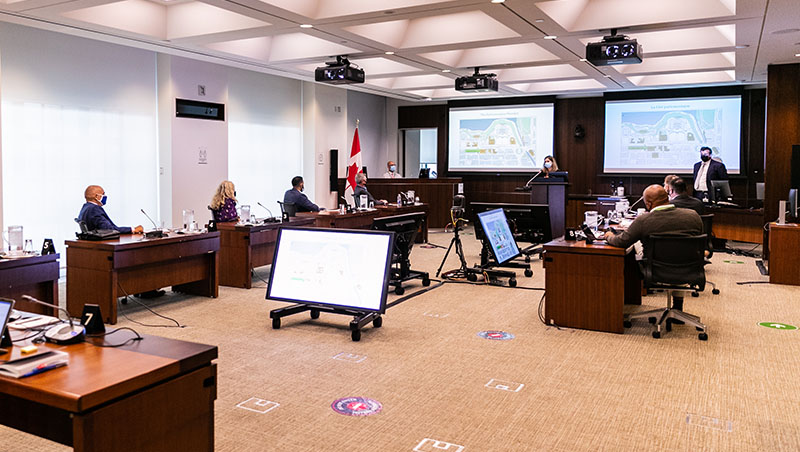
Experienced employees of the Administration took on one of the following three roles:
- Liaison officers help newly elected Members obtain on-site support with onboarding;
- Transition officers assist departing Members with all activities surrounding the closing of their offices; and
- Advisors assist re-elected Members by coordinating the work involved in transitioning from one parliament to the next.
An orientation centre welcomed Members’ during their first days on Parliament Hill, and an integrated learning portal gave Members and their employees access to online and in-person training. Key orientation topics included an overview of Parliamentary Precinct buildings and services as well as information on human resources and staffing, budgets, technology, health and safety, security, and procedural and legal matters.
Although the Program has now ended, Members and their employees continue to have access to educational material through online training and information sessions. The Administration provides a variety of resources on its learning portal to support them throughout their mandate.
Support for departing Members
To assist Members who did not seek re-election and those who were not re-elected, as well as their employees, a transition team oversaw the delivery of a range of services, including help to vacate parliamentary and constituency offices. A service centre was set up on Parliament Hill for departing Members and their employees.
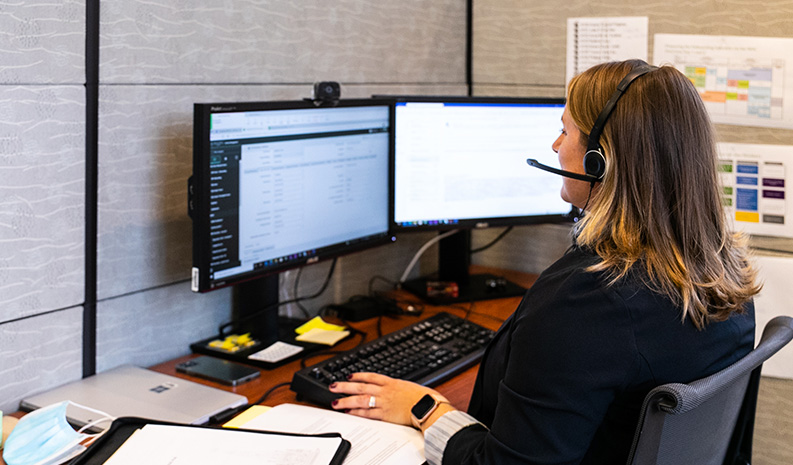
Improved access to parliamentary information
To make parliamentary information more readily available to Members and the public, the Administration partnered with the Senate and the Library of Parliament this past year to renew the LEGISinfo website. All bills before the Senate and the House of Commons are tracked on this Web-based tool. New features were added and the search functionality was improved to allow full-text searches of bills, improve navigation, and make the user experience more accessible and mobile friendly.
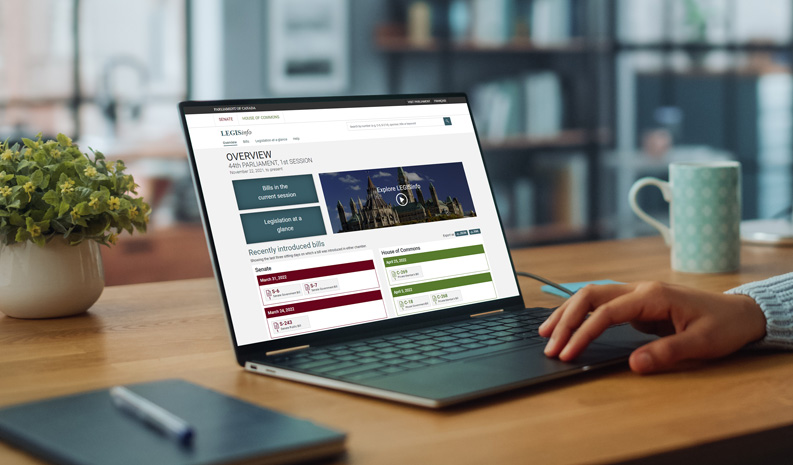
Unified and seamless services
A simplified service experience for Members
In May 2018, Administration employees from various sectors banded together to provide in-person services to Members. Now four years on since its inception, this team—called Sourceplus—has become an important resource for Members in their daily business. There are four Sourceplus service centres located throughout the Parliamentary Precinct, where Members and their employees can request services and in-person assistance on a variety of topics, such as IT support, equipment and expense claim submission.
During an election period, the Sourceplus team joins forces with the Members’ Orientation Program to provide personalized support to Members.
Beginning in 2022, Administration teams that offer phone and email support in the areas of building management, precinct access, financial services, and IT enquiries will come together to form one team, coordinating with Sourceplus advisors. This new centralized team will focus on identifying ways to extend the streamlined, multidisciplinary service model to provide a simplified and seamless experience to Members and their employees.
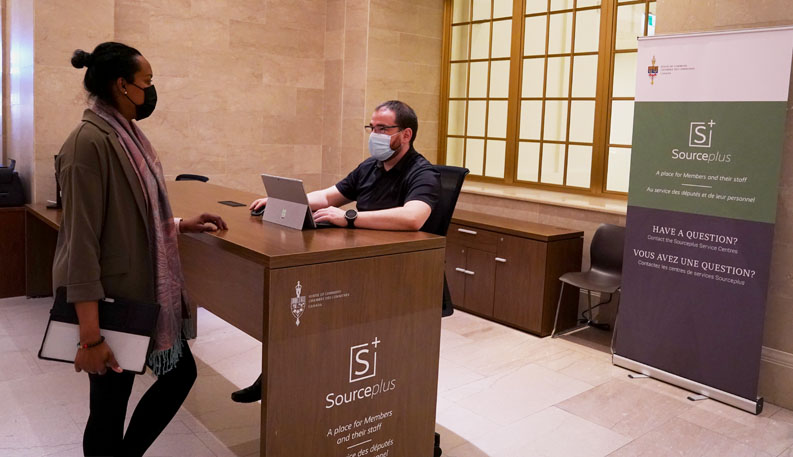
The importance of protecting information
One of the ways that the Administration supports Members is by protecting information on parliamentary activities. To this end, the House has developed its own program, which includes enhanced cybersecurity measures and security tools. The Administration has a robust cybersecurity structure in place and, this year, it deployed a renewed and enhanced constituency connectivity service across the country. This service improves cybersecurity for the House of Commons as well as for constituency offices equipped with House-managed computers. This way, Members benefit from the same cybersecurity protection and IT services in their constituency offices as on the Hill.
Empowered and engaged workforce
Inclusion: the House Administration’s newest value
The Anti-Racism Subcommittee published its first report in June 2021. The Subcommittee’s mandate is to propose meaningful action to help guide the Administration’s efforts toward building and maintaining an anti-racist culture in the workplace. Shortly after the report’s publication, the Strategic Plan was updated to add a new core value: “Inclusion: We value diversity and inclusion, and empower everyone to bring their whole selves to work.” The Administration also unveiled a statement signed by every member of the Clerk’s Management Group, affirming their commitment to fostering diversity and inclusion and to implementing a House-wide, collective approach to anti-racism at all levels.
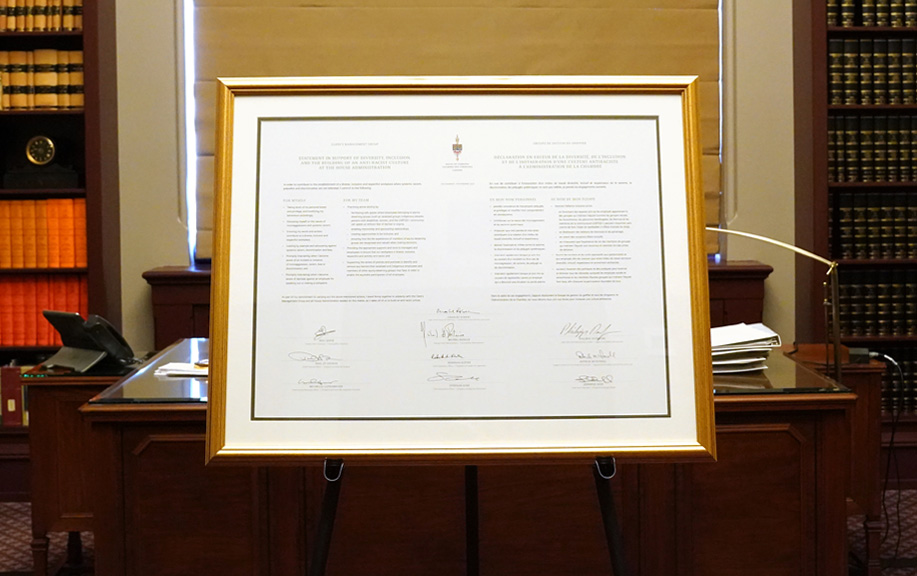
Ensuring health and safety awareness and compliance
In compliance with Part II of the Canada Labour Code and its Regulations, the Administration continued to ensure health and safety awareness at all levels of the organization through a renewal of its policies and procedures. It also provided training, including on the prevention of harassment and violence in the workplace to Members and their employees, and to Administration employees.
A new online application was launched this year which makes it easier for Administration employees to report and manage work-related incidents, hazardous situations, work refusals, and workplace inspections. The House also conducted a series of corporate health and safety risk assessments to ensure that control measures are in place to raise awareness and protect employees from work-related injuries or occupational illnesses.
Collecting employee feedback
The House of Commons conducted an Employee Engagement Survey in 2018 to gauge the employee experience and better understand what motivates employees to succeed. The participation rate in the survey was high and the compilation of the results allowed the House to identify specific areas of concern on which to act in response to the findings. This year, progress was made on various aspects of this corporate action plan, including:
- documenting and communicating corporate planning and decision-making processes;
- researching change management and meeting best practices;
- prioritizing and evaluating employee communications throughout the COVID-19 pandemic;
- launching a streamlined competency framework; and
- enhancing learning for managers and employees.
These activities foster a culture of engagement in which all employees are empowered to provide the best and most innovative support and services to Members of Parliament.
The COVID-19 pandemic also meant that the organization needed to gather feedback from employees to understand and address the situation’s impacts on their daily activities. Pulse surveys were conducted to help guide decisions and ensure that employees are getting the support they need. In collaboration with its parliamentary partners and public health authorities, the House Administration provided regular COVID-19 updates to keep employees informed while protecting their health and safety.

Modernized physical spaces and associated services
Latest progress on the rehabilitation of the Parliamentary Building
Due to the major restoration that began in 2019, the Parliament Building has been a busy site all year, with extensive work taking place both inside and outside the building. Excavation for the new Parliamentary Welcome Centre is underway, as is work to restore the masonry on the north facade. Interpretive panels about the rehabilitation of the Parliament Building have been set up around the worksite to inform visitors about the project. The working group composed of Members of Parliament from all recognized parties reconvened after the general election to ensure that the input of parliamentarians is reflected in the development and design of the building.
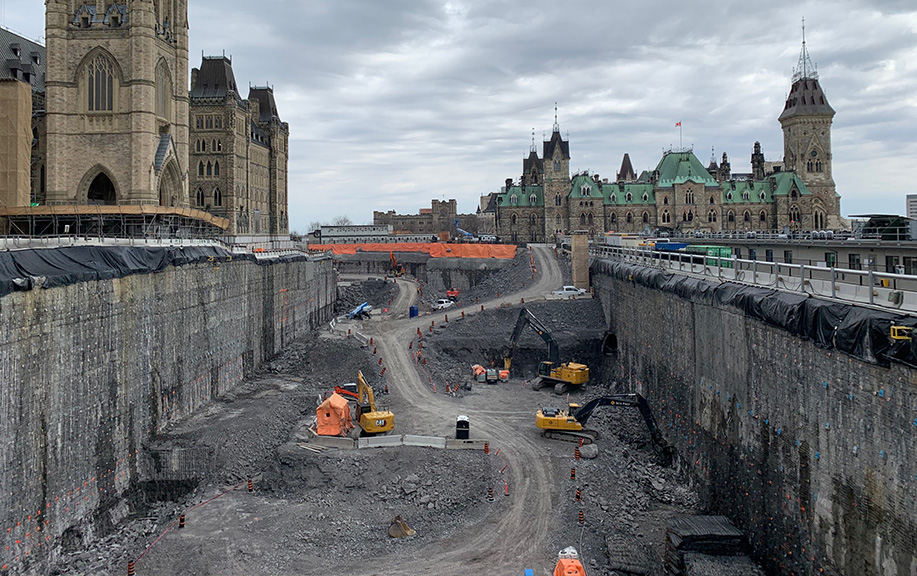
Temporary silencing of the carillon
As part of the work underway to restore the Peace Tower, the carillon is now silent to allow for the restoration of its belfries, bells, and support spaces. Dr. Andrea McCrady, the Dominion Carillonneur of Canada since 2008, played a closing recital on February 23, 2022.
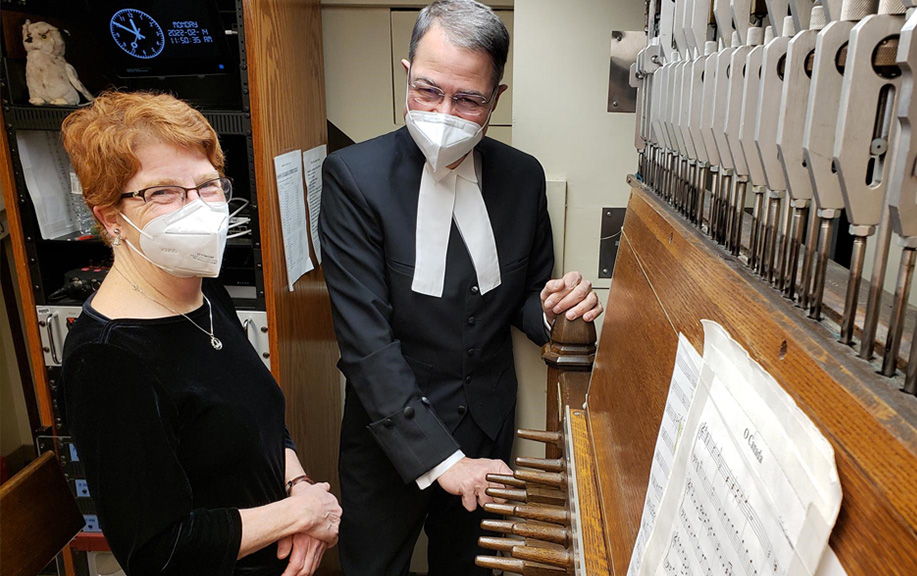
A growing Heritage Collection
There are over 5,000 works of art, official portraits, historical paintings, ceremonial objects and pieces of furniture in the House of Commons Heritage Collection. As an example, the Clerk’s Table—which stands in the centre of the House of Commons Chamber—is an important part of this collection.
The first Clerk’s Table, built in 1866, was destroyed in the fire that consumed the Parliament Building in 1916. A new Clerk’s Table was built and installed in the Chamber in 1921. On the centenary of the installation of this replacement table, the House Administration created a replica to stand in the place of the one-hundred-year-old table in the Chamber while the latter undergoes a complete restoration.
The Speaker’s Chair in the House of Commons Chamber is an excellent example of how an object may serve both a symbolic and functional purpose. This year, the family of the Hon. Albert Sévigny, Speaker of the House of Commons from 1916 to 1917, donated the chair that was used while the House sat in the Victoria Memorial Building after the fire in 1916 to the Heritage Collection.

Did you know?
Prior to 1921, a new chair was built for every Speaker, which they took with them at the end of their mandate. The last chair commissioned for an individual Speaker was the one used by the Hon. Edgar N. Rhodes. The “Rhodes chair,” as it is commonly called, found its way back to the House of Commons in 2005 and is now being used in the West Block interim Chamber.
Financial Information
This section presents a snapshot of 2021–2022 financial information regarding Members of Parliament and the House Administration. For more information on the proactive publication of financial information, see the Reports and Disclosure section of ourcommons.ca.
| Main Estimates |
Supplementary
Estimates and Adjustments |
Total Authorities | Actual Spending | Surplus / (Deficit) | |
|---|---|---|---|---|---|
| Statutory | |||||
| Members and House Officers | 116,661 | (11,020) | 105,641 | 105,641 | - |
| Employee Benefit Plans | 43,524 | (2,805) | 40,720 | 40,720 | - |
| Total Statutory | 160,185 | (13,825) | 146,361 | 146,361 | - |
| Non-statutory | |||||
| Members and House Officers | 177,953 | 7,126 | 185,079 | 164,497 | 20,581 |
| Committees, Parliamentary Associations and Parliamentary Exchanges |
7,996 | (280) | 7,715 | 1,277 | 6,439 |
| House Administration | 197,553 | 10,876 | 208,429 | 197,960 | 10,469 |
| Total Non-Statutory | 383,502 | 17,722 | 401,224 | 363,734 | 37,489 |
| TOTAL | 543,687 | 3,897 | 547,584 | 510,095 | 37,489 |
Note: Figures may not add up to total due to rounding.
|
Actual Spending1 (in thousands of dollars) |
FTE Budget2 | |
|---|---|---|
| Office of the Clerk and Secretariat | 6,774 | 62 |
| Procedural Services | 28,647 | 329 |
| Office of the Law Clerk and Parliamentary Counsel | 4,851 | 38 |
| Office of the Deputy Clerk, Administration | 6,224 | 52 |
| Parliamentary Precinct Operations | 28,092 | 470 |
| Office of the Sergeant-at-Arms and Corporate Security | 6,731 | 68 |
| Digital Services and Real Property | 78,534 | 441 |
| Human Resources Services | 20,345 | 162 |
| Finance Services | 17,763 | 186 |
| TOTAL | 197,960 | 1,807 |
Note: Figures may not add up to total due to rounding.
1 Salaries (excluding Employee Benefit Plans) and operating expenditures
2 Budgeted number of permanent full-time equivalent (FTE) employees